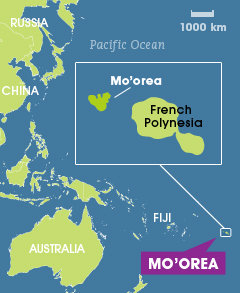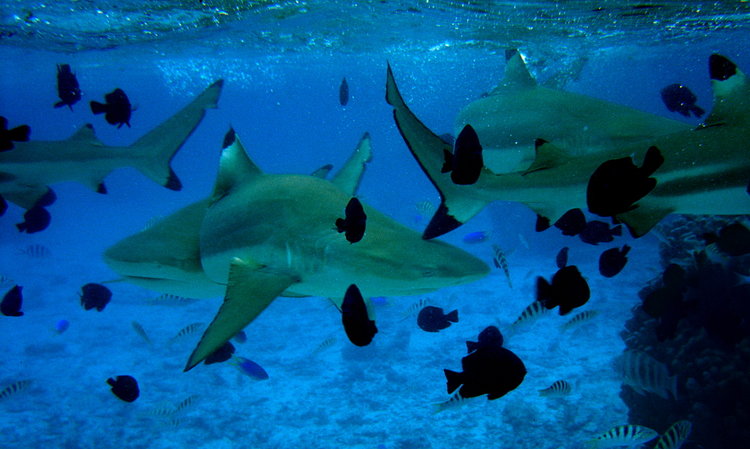Send to a friend
The details you provide on this page will not be used to send unsolicited email, and will not be sold to a 3rd party. See privacy policy.

The entire ecosystem of Mo’orea, a volcanic island in French Polynesia, will be captured in a computer model that seeks to understand how climate change and human activities affect the local environment.
Last month, an international group of researchers announced they want to feed decades of Mo’orea research from various fields into a computer-based model of the 132 square kilometre island.
The Moorea Island Digital Ecosystem Avatar (Moorea IDEA) will model the island from its peak to the surrounding sea, including fish, corals, plants and its population of around 17,000 people. It is designed to enable researchers and local people to visualise and predict how different factors relating to climate change and human development influence each other and the island.
For example, the model is intended to show how coral reefs change when the sea level rises and what environmental policies are needed to maintain fish stocks.
Mo’orea is already well studied. France has operated a field station there, the Centre for Island Research and Environment Observatory (CRIOBE), there since 1971, while the University of California, Berkeley’s research station will celebrate its 30th anniversary next month.
“We have a lot of data,” says Joachim Claudet, one of the ecologists behind the project. “For example, the CRIOBE has data series about coral reefs covering more than 30 years.”
Claudet works at the National Centre for Scientific Research in France. His own project, INTHENSE, aims to model the complex relationships between human activities, such as fishing and tourism, and natural ecosystems in Mo’orea’s coastal areas.
Moorea IDEA would use these and other research results, including genetic data, high-resolution satellite images, social science surveys and archaeological data, explains Matthias Troyer, a physicist at the Swiss Federal Institute of Technology in Zurich, who is leading the data crunching part of the project.
Although this involves only a low volume of data — they would fit on a personal computer’s hard disk — integrating them will be a challenge, Troyer says. “Some is in French, some is in English, some is in databases, some in PDF files or in Excel spreadsheets,” he explains.
Once Moorea IDEA is built, scientists will be able to add fresh data, allowing the avatar to learn over time, refine predictions and reveal unforeseen relationships between data sets, says Claudet. Local decision-makers will be encouraged to use the model to test and visualise different policy scenarios.
For the moment, the scientists expect to spend around €5 million (about US$5.7 million) over three years to show what a Moorea IDEA data model could achieve. Completing the whole project would then require another five to ten years’ work, according to Troyer.
Ecologist Eric Clua, who represents France’s research ministry in French Polynesia, says he remains cautiously enthusiastic about the project’s value. He hopes that Moorea IDEA will offer more than an online tool to “play around with”, by enabling inhabitants to plan their future in terms of environmental impacts of economic activity.
“If it manages to model [ecosystems] from the top of the mountain to the bottom of the reef, we will have a tool to help decision-making that doesn’t exist yet in such a comprehensive way,” says Clua, who has attended INTHENSE and Moorea IDEA meetings but is not part of the teams behind these projects.
For instance, instead of relying on an ad hoc study of a particular fish resource to regulate fishing activities, Moorea IDEA could reveal how deforestation to allow pineapple planting affects water runoff and erosion, and in turn rivers and fish populations. At present, these connections are poorly understood, Clua says.
Whatever the project’s final outcome, Clua says Moorea IDEA has already brought together research teams from different countries and disciplines that had worked in their own corners of Mo’orea for years.
Last month, an international group of researchers announced they want to feed decades of Mo’orea research from various fields into a computer-based model of the 132 square kilometre island.
The Moorea Island Digital Ecosystem Avatar (Moorea IDEA) will model the island from its peak to the surrounding sea, including fish, corals, plants and its population of around 17,000 people. It is designed to enable researchers and local people to visualise and predict how different factors relating to climate change and human development influence each other and the island.
For example, the model is intended to show how coral reefs change when the sea level rises and what environmental policies are needed to maintain fish stocks.
Mo’orea is already well studied. France has operated a field station there, the Centre for Island Research and Environment Observatory (CRIOBE), there since 1971, while the University of California, Berkeley’s research station will celebrate its 30th anniversary next month.
“We have a lot of data,” says Joachim Claudet, one of the ecologists behind the project. “For example, the CRIOBE has data series about coral reefs covering more than 30 years.”
Claudet works at the National Centre for Scientific Research in France. His own project, INTHENSE, aims to model the complex relationships between human activities, such as fishing and tourism, and natural ecosystems in Mo’orea’s coastal areas.
Moorea IDEA would use these and other research results, including genetic data, high-resolution satellite images, social science surveys and archaeological data, explains Matthias Troyer, a physicist at the Swiss Federal Institute of Technology in Zurich, who is leading the data crunching part of the project.
Although this involves only a low volume of data — they would fit on a personal computer’s hard disk — integrating them will be a challenge, Troyer says. “Some is in French, some is in English, some is in databases, some in PDF files or in Excel spreadsheets,” he explains.
Once Moorea IDEA is built, scientists will be able to add fresh data, allowing the avatar to learn over time, refine predictions and reveal unforeseen relationships between data sets, says Claudet. Local decision-makers will be encouraged to use the model to test and visualise different policy scenarios.
For the moment, the scientists expect to spend around €5 million (about US$5.7 million) over three years to show what a Moorea IDEA data model could achieve. Completing the whole project would then require another five to ten years’ work, according to Troyer.
Ecologist Eric Clua, who represents France’s research ministry in French Polynesia, says he remains cautiously enthusiastic about the project’s value. He hopes that Moorea IDEA will offer more than an online tool to “play around with”, by enabling inhabitants to plan their future in terms of environmental impacts of economic activity.
“If it manages to model [ecosystems] from the top of the mountain to the bottom of the reef, we will have a tool to help decision-making that doesn’t exist yet in such a comprehensive way,” says Clua, who has attended INTHENSE and Moorea IDEA meetings but is not part of the teams behind these projects.
For instance, instead of relying on an ad hoc study of a particular fish resource to regulate fishing activities, Moorea IDEA could reveal how deforestation to allow pineapple planting affects water runoff and erosion, and in turn rivers and fish populations. At present, these connections are poorly understood, Clua says.
Whatever the project’s final outcome, Clua says Moorea IDEA has already brought together research teams from different countries and disciplines that had worked in their own corners of Mo’orea for years.














